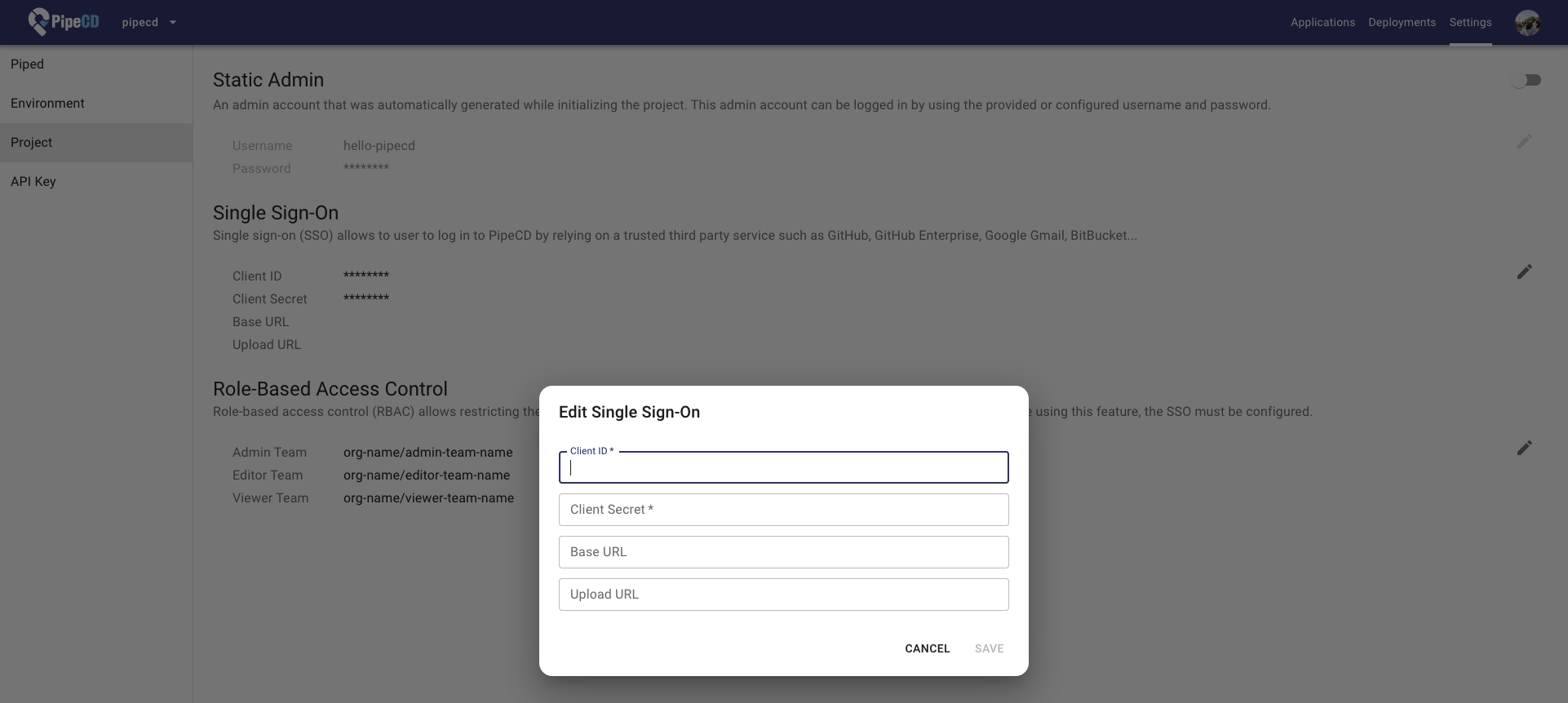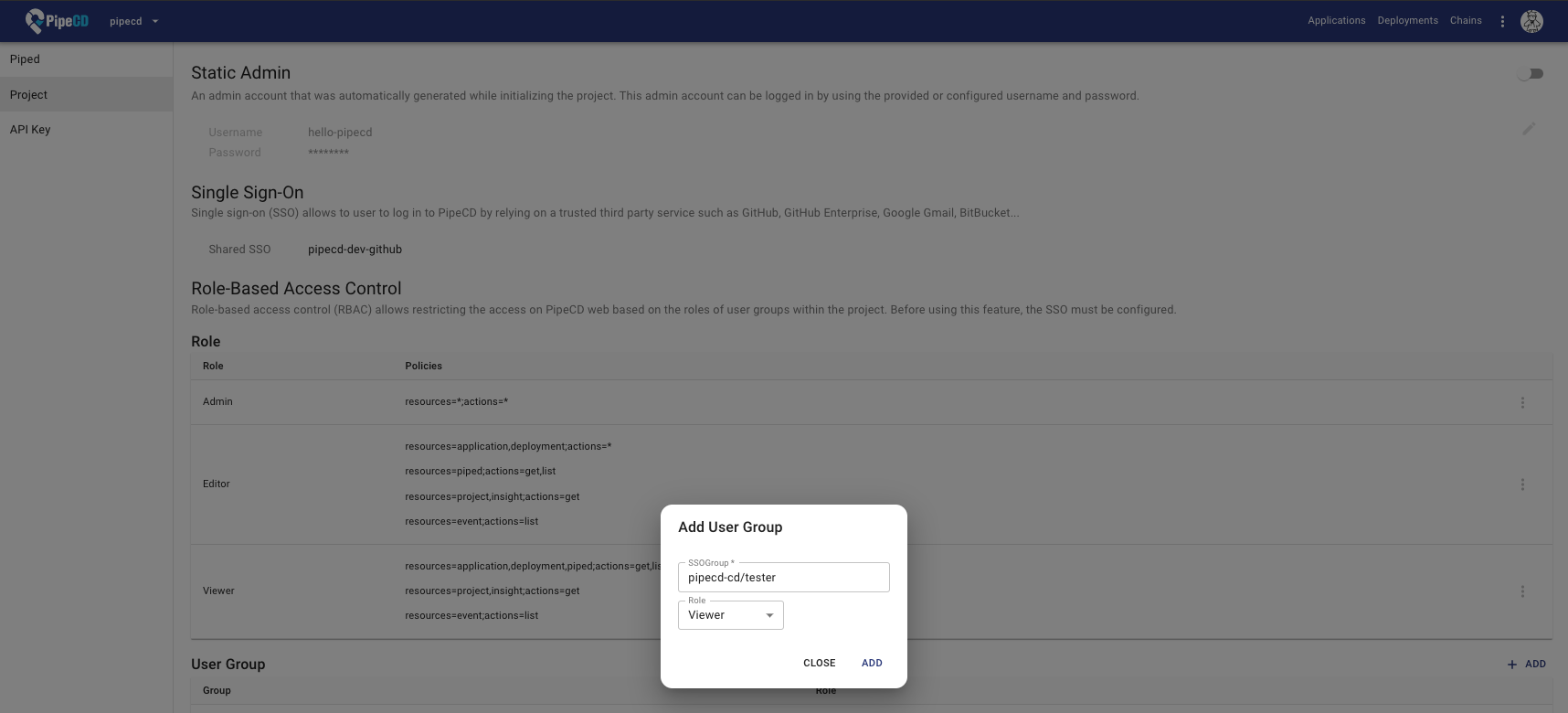Authentication and authorization

Static Admin
When the PipeCD owner adds a new project, an admin account will be automatically generated for the project. After that, PipeCD owner sends that static admin information including username, password strings to the project admin, who can use that information to log in to PipeCD web with the admin role.
After logging, the project admin should change the provided username and password. Or disable the static admin account after configuring the single sign-on for the project.
Single Sign-On (SSO)
Single sign-on (SSO) allows users to log in to PipeCD by relying on a trusted third-party service.
Supported service
- GitHub
Note: In the future, we want to support such as Google Gmail, Bitbucket…
Before configuring the SSO, you need an OAuth application of the using service. For example, GitHub SSO requires creating a GitHub OAuth application as described in this page:
https://docs.github.com/en/developers/apps/creating-an-oauth-app
The authorization callback URL should be https://YOUR_PIPECD_ADDRESS/auth/callback.

The project can be configured to use a shared SSO configuration (shared OAuth application) instead of needing a new one. In that case, while creating the project, the PipeCD owner specifies the name of the shared SSO configuration should be used, and then the project admin can skip configuring SSO at the settings page.
Role-Based Access Control (RBAC)
Role-based access control (RBAC) allows restricting access on the PipeCD web-based on the roles of user groups within the project. Before using this feature, the SSO must be configured.
PipeCD provides three built-in roles:
Viewer: has only permissions to view existing resources or data.Editor: has all viewer permissions, plus permissions for actions that modify state, such as manually syncing application, canceling deployment…Admin: has all editor permissions, plus permissions for updating project configurations.
Configuring the PipeCD’s roles
The below table represents PipeCD’s resources with actions on those resources.
| resource | get | list | create | update | delete |
|---|---|---|---|---|---|
| application | ○ | ○ | ○ | ○ | ○ |
| deployment | ○ | ○ | ○ | ||
| event | ○ | ||||
| piped | ○ | ○ | ○ | ○ | |
| project | ○ | ○ | |||
| apiKey | ○ | ○ | ○ | ||
| insight | ○ |
Each role is defined as a combination of multiple policies under this format.
resources=RESOURCE_NAMES;actions=ACTION_NAMES
The * represents all resources and all actions for a resource.
resources=*;actions=ACTION_NAMES
resources=RESOURCE_NAMES;actions=*
resources=*;actions=*
Configuring the PipeCD’s user groups
User Group represents a relation with a specific team (GitHub)/group (Google) and an arbitrary role. All users belong to a team/group will have all permissions of that team/group.
In case of using the GitHub team as a PipeCD user group, the PipeCD user group must be set in lowercase. For example, if your GitHub team is named ORG/ABC-TEAM, the PipeCD user group would be set as ORG/abc-team. (It’s follow the GitHub team URL as github.com/orgs/{organization-name}/teams/{TEAM-NAME})
Note: You CANNOT assign multiple roles to a team/group, should create a new role with suitable permissions instead.

Feedback
Was this page helpful?
Glad to hear it! Please tell us how we can improve.
Sorry to hear that. Please tell us how we can improve.